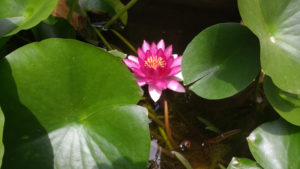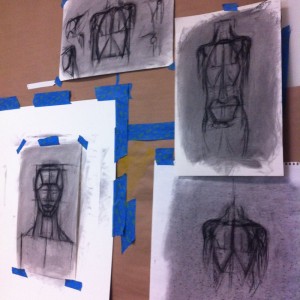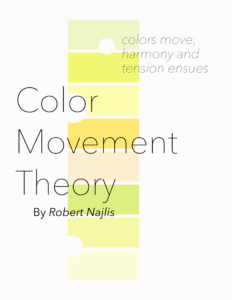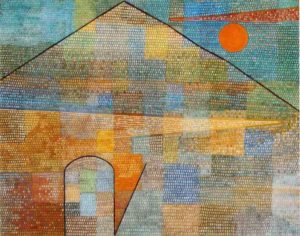
Paul Klee, Musician or Painter
Perhaps the biggest decision in Paul Klee’s life was whether to pursue a career as a musician or as a painter, as both paths were open to him. His parents were both musicians and his father was a professor of music. By age 11, Klee was an accomplished musician performing as an extra with the Bern symphony. In the end he chose painting, as he felt that the great days of music were in the past, whereas those of painting were yet to come.1
Klee especially liked the music of the 18th century, composers such as Bach, Mozart and Beethoven, as well as Haydn and Schubert. He preferred the chamber music of the Viennese school because, as his friend and biographer, Will Grohmann, states, “he found that it stimulated his sense of form and provided him with a sure guide through the labyrinth of his own formal invention.”2
Klee agreed with Goethe that color and sound should not be directly compared, rather that both should be derived from a higher law. As Goethe said in the Theory of Colors, “Colour and sound do not admit of being directly compared together in any way, but both are referable to a higher formula, both are derivable, although each for itself, from this higher law. They are like two rivers which have their source in one and the same mountain, but subsequently pursue their way under totally different conditions in two totally different regions, so that throughout the whole course of both no two points can be compared.”3 Klee looked to music as a means to derive an organizing principle for painting. He was not looking to make paintings that were merely musically inspired or that had a musical type of feeling. Instead, he was looking to the principles of music as a way of thinking about composition in painting. According to Klee, what had already been done for music by the end of the eighteenth century had at last begun for the pictorial arts.
What was it that had been done for music and that was at last being done for the pictorial arts? In 1725 Johann Josef Flux published the landmark 18th century treatise on music theory, Gradus ad Parnassum, which introduced and codified the theories of counterpoint and polyphonic composition. This treatise had a profound influence on the composers of the Viennese classical school, such as Mozart, Haydn and Beethoven, all of whom learned the fundamental techniques of composition for the treatise.4
Polyphony, Counterpoint and Fugue
In music there are different ways of organizing the number of voices being used, the methods described below will be helpful in understanding the work that Paul Klee was doing with music and the visual arts.
Monophony
Monophony is the simplest form of music with just one part or voice being used. Even if there are various instruments or singers, if all the notes are played or sung in unison, even if in different octaves, this is considered monophony.

Homophony
In homophony there is one dominant melodic voice accompanied by chords. This can be seen below in the example from Frederic Chopin’s Nocturne, Op. 62 No 2. The chords are in the lower part of the diagram, the bass clef. Notice how the chords are formed by notes stacked one on top of another in a vertical fashion. The notes in the upper part of the diagram, the treble clef are arranged in a horizontal fashion, one next to the other. This sense of verticality versus horizontality is the principle difference between chords and melody notes.

Polyphony
Polyphony describes the general class of music where two or more voices acting as independent lines of melody are acting at the same time. This differs from homophony in which there is one melody line and line of chordal harmonics.
Counterpoint
Counterpoint is a form of polyphony that generally involves musical lines with strongly independent identities. It involves the study of the motion of musical lines relative to one another. The rules of counterpoint can be strict or freer, with most pieces adapting a freer interpretation of counterpoint to allow for musical freedom. Below is an example of counterpoint from Liszt’s B minor Sonata. Note how both lines are acting in a horizontal manner at the same time and in relation to one another.
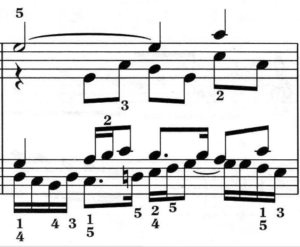
Fugue
A fugue is a contrapuntal composition in which a short melody or phrase (the subject) is introduced by one part and successively taken up by others and developed by interweaving the parts. In the example below, one can see how successive voices are introduced into the composition.
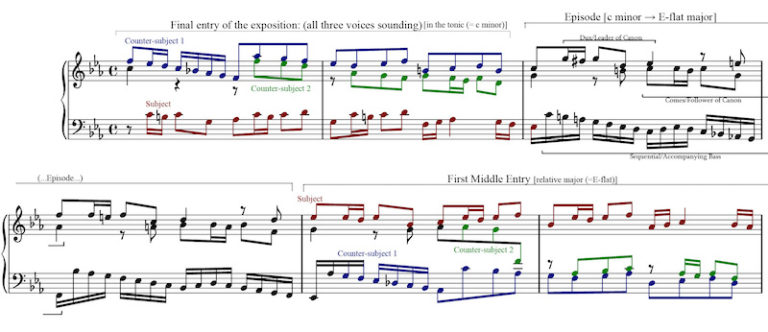
Klee’s Research into Music and Art
Cubism helped Klee to see the possibilities of music in the visual arts. In the alternating darks and lights he saw aspects of musical rhythm in the visual. Klee continued to further and refine his interest in music, rhythm and visual movement. His interest in individual lines of music as seen in counterpoint prompted him to attempt a visual translation of the different voices in the Adagio from J.S. Bach’s Sonata No. VI in G Major for violin and clavier.5
Klee studied the movement of the voices in counterpoint compositions. He created a large musical staff able to span three octaves thereby allowing him to visualize all of the voices in one large space. Below this area he described the quality of the beat, both in terms of dynamic changes as well as reproducible accents that corresponded to the overall meter of the piece. The curvilinear motion correlates to the movement of the melody, while the weight of the line expresses the rhythmic and melodic emphasis given to that voice at that time. This study lead Klee to further pursue this theme and consider the question of texture and voices in the visual arts.6

Structural Components
Klee distinguished between what he called individual and structural components in musical texture. Structural components are characterized by rhythmic repetition without variation. Thus they are divisible as they can be broken down into smaller units while still retaining the same basic structure. Individual components are rhythmically independent (non-repetitive) compositional entities that can not be subdivided into repeating parts, but can be combined with the supporting structural rhythm. Klee applied this to the study of the individual vs structural parts of a piece by Bach, giving the individual line more free reign, separating it from the structural part.7
Klee’s painting ‘Snake Paths’ takes this idea further, with the snake acting as an individual melodic voice over the visual counterpoint of the structural shapes echoing and interacting with the snake’s movement.
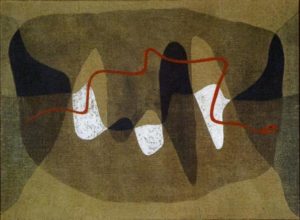
Fugue in Painting
In the painting Fugue in Red, Klee worked in style of the fugue, with repeating forms entering at different times. About this piece, Klee said: “The repetitive characteristic of structures is here the concept of increase or decrease which is repeated at every step. If the naturally ordered movement perceived with the ears instead of the eyes is comparable to the movements of natural tones, the artfully ordered movement is reminiscent of the structured division of tones we find in musical scales.” 8
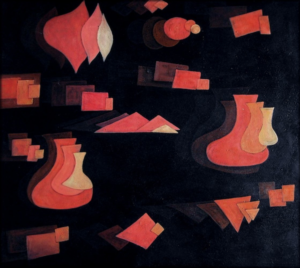
Rhythmic Landscape
In the painting Rhythmic Landscape with Trees, Klee used trees as a kind of rhythmic notation set upon horizontal staff lines. 9 He started to think about creating discrete elements in his painting that can correspond to musical notes, elements of time and space, movement (color/notes). The idea of individual structural elements in painting that would act similarly to notes is an idea that would be developed further in later paintings.
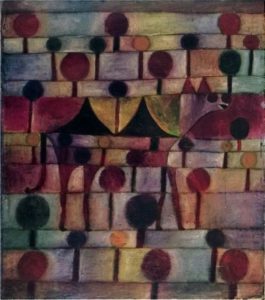
Flat Color Grid
Klee further developed the flat color grid idea, using color grid squares as notes. In the painting Alter Klang (ancient sound) Klee utilized the color grid idea. Part of the original inspiration for this painting came from Leonardo da Vinci’s St John the Baptist. However, Klee changed from Leonardo’s continuous range of dark to light into discrete value in a grid like format.
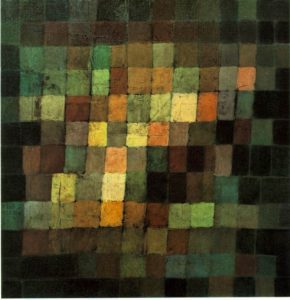
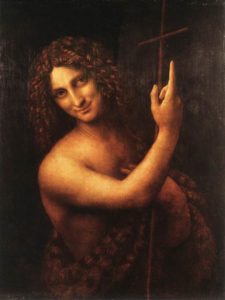
New Harmony and twelve-tone music
By early 20th century, composers of contemporary classical music were not writing in major minor keys anymore, they were not writing music that fit in one tonality. Schoenberg developed his idea of atonality, which he used to give all 12 notes equal importance, and to avoid being locked into one key. The basis of this twelve-tone technique is to arrange all twelve notes of the chromatic scale into a row of notes, and the inverted and rearrange them in various ways throughout the composition. Composers such as Aaron Copland and Igor Stravinsky also used this technique. In the painting New Harmony, Klee employs a similar idea of 12 tones of color that are repeated in a bilateral inverted symmetry.
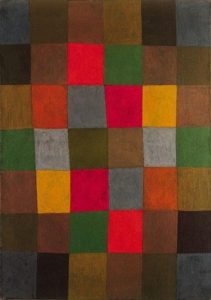
Polyphony and the Dot Screen
Klee’s ideas on polyphony in the visual arts did not grow alone. Through conversation with Robert Delaunay and looking at his works, such as Blue Rider and Simultaneous Window, Klee was able to further his thoughts on polyphony in the visual arts. With the help of Delaunay, Klee had come to see pictorial polyphony as tied together with transparent color depth. However, Klee eventually found Delaunay’s use of transparencies lacking in the kind of structure and definition he desired to provide organization for his compositions. Klee found that using overlapping transparencies resulted in both themes being destroyed and merged into one, rather than being held up as separate but related voices.
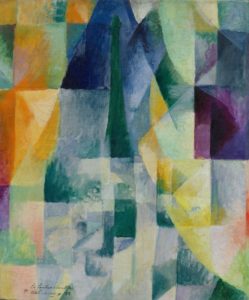
Simultaneous Harmonic Relationship
Realizing that he needed a planar color space that would be more unified as well as more transparent, Klee experimented with various formats and ideas, eventually developing what he called his “so-called pointillism.” 10 This technique was not in fact pointillism, instead it was more of a dot screen. First he set down one theme in the ground plane of the painting. Over that plane he laid a screen of white dots. The white dots provided a new surface to paint on, while not completely covering the bottom plane. Thus, with the bottom plane still visible, over the white dots he applied a wash or series of washes to gain the effects of space and color. This process resulted in two fully independent themes. Each theme was visible independently as well as together.
This technique of so-called pointillism is best seen in Klee’s great work Ad Parnassum. The title of the work references directly Fux’s treatise on musical polyphony, Gradus ad Parnassum. The painting shows two fully independent yet related themes. As in late 18th century musical polyphony, the painting Ad Parnassum shows a simultaneous harmonic relationship, rather than a sequential one. Finally, Klee had succeeded in creating the kind of visual polyphony he had been working on ever since he first began to study the movements of voices in Bach’s counterpoint.
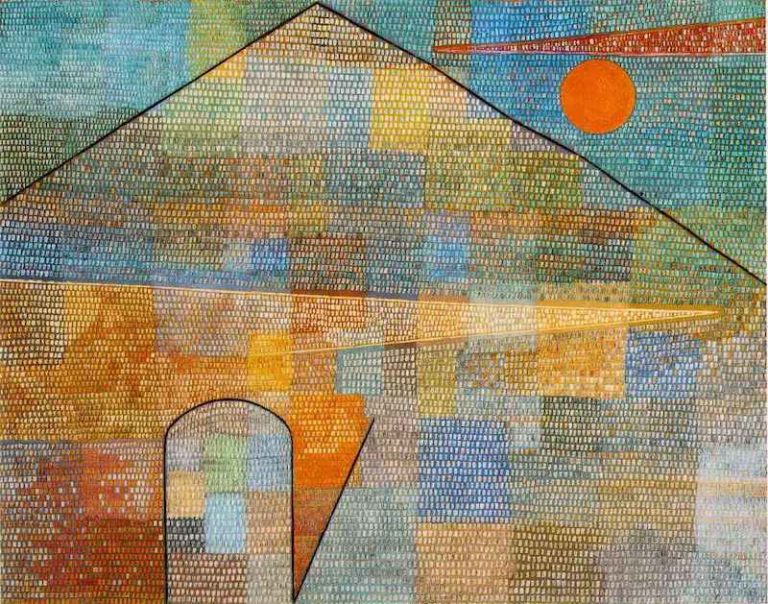
Pictorial Depth
While Klee’s ultimate goal was color polyphony, he was also aware of the current trends in painting. As painting was moving towards a flatter space, he still wanted to keep a sense of space so as to avoid having the work end up as decoration. Klee understood linear perspective to be a dead metaphor 11 so he worked towards alternate means of preserving a sense of space and depth. Furthermore, he looked to codify and safeguard the traditions of pictorial depth and transparent color just as Fux had safeguarded the polyphonic tradition in music.
Fux dealt with fundamental principles of harmony and counterpoint, though tastes might change, the fundamental principles of composition do not. Klee sought to do the same with painting, lay down fundamental principles of working in polyphonic themes, preserving depth and and space. Klee was very aware of the history of painting and saw himself as part of that. He saw the transparent color interaction as part of painting tradition going back to Leonardo da Vinci, as well as having roots in the glazing techniques of early Flemish masters. 12
References:
1. Andrew Kagan, Paul Klee / Art and Music (London: Cornell University Press, 1983)
2. Richard Verdi, Musical Influences on the Art of Paul Klee, Art Institute of Chicago Museum Studies, Vol. 3 (1968), pp. 81-107
3. Johann Wolfgang von Goethe, Theory of Colors, Translated by Charles Lock Eastlake, R.A., F.R.S (London, Wlliam Clowes and Sons, 1840) pg 298
4. Andrew Kagan, Paul Klee / Art and Music (London: Cornell University Press, 1983)
5. Richard Verdi, Musical Influences on the Art of Paul Klee, Art Institute of Chicago Museum Studies, Vol. 3 (1968), pp. 81-107
6. Ibid
7. Ibid
8. Galen Johnson, The Retrieval of the Beautiful: Thinking Through Merleau-Ponty’s Aesthetics, (Illinois: Northwestern University Press, Dec 31, 2009)
9. Andrew Kagan, Paul Klee / Art and Music (London: Cornell University Press, 1983)
10. Ibid
11. Ibid
12. Ibid


